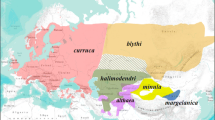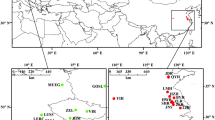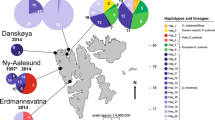Abstract
Gomphiocephalus hodgsoni (Collembola) is the most common and widely distributed arthropod in the Dry Valleys of southern Victoria Land, and is genetically diverse with over 70 mitochondrial cytochrome c oxidase subunit I (COI) haplotypes. There is also considerable physiological variation among G. hodgsoni individuals in their cold tolerance and metabolic activity. Here, we assessed genetic haplotypes of G. hodgsoni relative to the environmental conditions during which individuals were active. We sequenced the COI region of 151 individuals collected in pitfall traps from three sites within Taylor Valley and found 19 unique haplotypes that separated into two distinct lineages (1.6 % divergence), with one lineage comprising 80 % of the sequenced population. During two-hourly sampling, air temperature was the strongest predictor of activity between the two lineages (R 2 = 0.56), and when combined with subsurface soil temperature, relative humidity and photosynthetically active radiation, explanatory power increased to R 2 = 0.71. With steadily increasing air temperatures predicted for much of Antarctica, it is likely that some haplotypes will have a selective advantage and potentially result in decreased genetic variability within populations. We suggest that temporal monitoring of the relative proportions of COI haplotypes or other appropriate genetic markers may provide a subtle measure of biological responses to environmental changes within Antarctic terrestrial ecosystems.







Similar content being viewed by others
References
Ballard JWO, Pichaud N (2013) Mitochondrial DNA: more than an evolutionary bystander. Funct Ecol 28:218–231
Bender EA, Case TJ, Gilpin ME (1984) Perturbation experiments in community ecology: theory and practice. Ecology 65:1–13
Blier PU, Lemieux H, Pichaud N (2013) Holding our breath in our modern world: will mitochondria keep the pace with climate changes? Can J Zool 92:591–601
Block W (1985) Ecological and physiological studies of terrestrial arthropods in the Ross Dependency 1984–85. Br Antarct Surv Bull 68:115–122
Cannon RJC, Block W (1988) Cold tolerance of microarthropods. Biol Rev 63:23–77
Clarke KR, Gorley RN (2006) PRIMER v6: user manual/tutorial. PRIMER-E, Plymouth
Convey P (2011) Antarctic terrestrial biodiversity in a changing world. Polar Biol 34:1629–1641
Convey P, Chown SL, Clarke A, Barnes DKA, Bokhorst S, Cummings V, Ducklow HW, Frati F, Green TGA, Gordon S, Griffiths HJ, Howard-Williams C, Huiskes AHL, Laybourn-Parry J, Lyons WB, McMinn A, Morley SA, Peck LS, Quesada A, Robinson SA, Schiaparelli S, Wall DH (2014) The spatial structure of Antarctic biodiversity. Ecol Monogr 84:203–244
Correa CC, Aw WC, Melvin RG, Pichaud N, Ballard JWO (2012) Mitochondrial DNA variants influence mitochondrial bioenergetics in Drosophila melanogaster. Mitochondrion 12:459–464
Darriba D, Taboada GL, Doallo R, Posada D (2012) jModelTest 2: more models, new heuristics and parallel computing. Nat Methods 9:772
Denton GH, Hughes TJ (2000) Reconstruction of the Ross ice drainage system, Antarctica, at the last glacial maximum. Geogr Ann Ser A Phys Geogr 82:143–166
Denton GH, Marchant DR (2000) The geological basis for a reconstruction of a grounded ice sheet in McMurdo Sound, Antarctica, at the last glacial maximum. Geogr Ann Ser A Phys Geogr 82:167–211
Doran PT, McKay CP, Clow GD, Dana GL, Fountain AG, Nylen T, Lyons WB (2002) Valley floor climate observations from the McMurdo dry valleys, Antarctica, 1986–2000. J Geophys Res 107:4772
Drummond AJ, Ashton B, Buxton S, Cheung M, Cooper A, Duran C, Field M, Heled J, Kearse M, Markowitz S, Moir R, Stones-Havas S, Sturrock S, Thierer T, Wilson A (2010) Geneious v5.1. Biomatters Ltd, Auckland. http://www.geneious.com
Fitzsimons JM (1971) Temperature and three species of Antarctic arthropods. Pacif Insects Monogr 25:127–135
Folmer O, Black M, Hoeh W, Lutz R, Vrijenhoek R (1994) DNA primers for amplification of mitochondrial cytochrome c oxidase subunit I from diverse metazoan invertebrates. Mol Mar Biol Biotechnol 3:294–299
Fraser CI, Terauds A, Smellie J, Convey P, Chown SL (2014) Geothermal activity helps life survive glacial cycles. Proc Natl Acad Sci USA 111:5634–5639
Green TGA, Sancho LG, Türk R, Seppelt RD, Hogg ID (2011) High diversity of lichens at 84°S, Queen Maud Mountains, suggests preglacial survival of species in the Ross Sea region, Antarctica. Polar Biol 34:1211–1220
Greenslade P, Stevens MI, Torricelli G, D’Haese CA (2011) An ancient Antarctic endemic genus restored: morphological and molecular support for Gomphiocephalus hodgsoni (Collembola: Hypogastruridae). Syst Entomol 36:223–240
Hawes TC (2011) Rafting in the Antarctic springtail, Gomphiocephalus hodgsoni. Antarct Sci 23:456–460
Hawes TC, Torricelli G, Stevens MI (2010) Haplotype diversity in the Antarctic springtail Gressittacantha terranova at fine spatial scales—a Holocene twist to a Pliocene tale. Antarct Sci 22:766–773
Hebert PD, Cywinska A, Ball SL (2003) Biological identifications through DNA barcodes. Proc R Soc Lond B Biol Sci 270:313–321
Hogg ID, Wall DH (2011) Global change and Antarctic terrestrial biodiversity. Polar Biol 34:1625–1627
Hogg ID, Cary SC, Convey P, Newsham KK, O’Donnell AG, Adams BJ, Aislabie J, Frati F, Stevens MI, Wall DH (2006) Biotic interactions in Antarctic terrestrial ecosystems: are they a factor? Soil Biol Biochem 38:3035–3040
Hopkin SP (1997) Biology of the springtails (Insecta: Collembola). Oxford University Press, New York
Hopkins DW, Sparrow AD, Novis PM, Gregorich EG, Elberling B, Greenfield LG (2006) Controls on the distribution of productivity and organic resources in Antarctic Dry Valley soils. Proc R Soc Lond B Biol Sci 273:2687–2695
Ivanova NV, Dewaard JR, Hebert PDN (2006) An inexpensive, automation-friendly protocol for recovering high-quality DNA. Mol Ecol Notes 6:998–1002
Janetschek H (1963) On the terrestrial fauna of the Ross-Sea area, Antarctica (preliminary report). Pac Insects 5:305–311
Janetschek H (1970) Environments and ecology of terrestrial arthropods in the high Antarctic. In: Holdgate MW (ed) Antarctic ecology, vol 2. Academic Press, London, pp 871–885
Kennedy AD (1993) Water as a limiting factor in the antarctic terrestrial environment: a biogeographical synthesis. Arct Alp Res 25:308–315
Köhler H-R, Eckwert H, Triebskorn R, Bengtsson G (1999) Interaction between tolerance and 70 kDa stress protein (hsp70) induction in collembolan populations exposed to long-term metal pollution. Appl Soil Ecol 11:43–52
Levy J, Lyons WB, Adams B (2013) Understanding terrestrial ecosystem response to Antarctic climate change. Eos Trans Am Geophys Union 94:33
Marchant DR, Head JW (2007) Antarctic dry valleys: microclimate zonation, variable geomorphic processes, and implications for assessing climate change on Mars. Icarus 192:187–222
McGaughran A, Convey P, Stevens MI, Chown SL (2010) Metabolic rate, genetic and microclimate variation among springtail populations from sub-Antarctic Marion Island. Polar Biol 33:909–918
McGaughran A, Hogg ID, Convey P (2011) Extended ecophysiological analysis of Gomphiocephalus hodgsoni (Collembola): flexibility in life history strategy and population response. Polar Biol 34:1713–1725
Nielsen UN, Wall DH (2013) The future of soil invertebrate communities in polar regions: different climate change responses in the Arctic and Antarctic? Ecol Lett 16:409–419
Nolan L, Hogg ID, Stevens MI, Haase M (2006) Fine scale distribution of mtDNA haplotypes for the springtail Gomphiocephalus hodgsoni (Collembola) corresponds to an ancient shoreline in Taylor Valley, Antarctica. Polar Biol 29:813–819
Peterson D, Howard-Williams C (2001) The latitudinal gradient project. Antarct NZ Spec Publ 6:1–46
Pichaud N, Ballard JWO, Tanguay RM, Blier PU (2012) Naturally occurring mitochondrial DNA haplotypes exhibit metabolic differences: insight into functional properties of mitochondria. Evolution 66:3189–3197
Ratnasingham S, Hebert PDN (2007) BOLD: the barcode of life data system (www.barcodinglife.org). Mol Ecol Notes 7:355–364
Reed DH, Frankham R (2003) Correlation between fitness and genetic diversity. Conserv Biol 17:230–237
Sinclair BJ, Sjursen H (2001) Cold tolerance of the Antarctic springtail Gomphiocephalus hodgsoni (Collembola, Hypogastruridae). Antarct Sci 13:271–279
Sinclair BJ, Stevens MI (2006) Terrestrial microarthropods of Victoria Land and Queen Maud Mountains, Antarctica: implications of climate change. Soil Biol Biochem 38:3158–3170
Smith TW, Wall DH, Hogg ID, Adams BJ, Nielsen UN, Virginia RA (2012) Thawing permafrost alters nematode viability and soil habitat characteristics in an Antarctic polar desert ecosystem. Pedobiologia 55:75–81
Steig EJ, Schneider DP, Rutherford SD, Mann ME, Comiso JC, Shindell DT (2009) Warming of the Antarctic ice-sheet surface since the 1957 international geophysical year. Nature 457:459–462
Stevens MI, Hogg ID (2002) Expanded distributional records of Collembola and Acari in Southern Victoria Land, Antarctica. Pedobiologia 46:485–495
Stevens MI, Hogg ID (2003) Long-term isolation and recent range expansion revealed for the endemic springtail Gomphiocephalus hodgsoni from Southern Victoria Land, Antarctica. Mol Ecol 12:2357–2369
Stevens MI, Hogg ID (2006) Contrasting levels of mitochondrial DNA variability between mites (Penthalodidae) and springtails (Hypogastruridae) from the Trans-Antarctic Mountains suggest long-term effects of glaciation and life history on substitution rates, and speciation processes. Soil Biol Biochem 38:3171–3180
Swofford D (2002) PAUP*: phylogenetic analysis using parsimony, version 4.0b10 for Macintosh. Sinauer Associates Inc Publishers, Sunderland
Tamura K, Peterson D, Peterson N, Stecher G, Nei M, Kumar S (2011) MEGA5: molecular evolutionary genetics analysis using maximum likelihood, evolutionary distance, and maximum parsimony methods. Mol Biol Evol 28:2731–2739
Tilbrook PJ (1967) The terrestrial invertebrate fauna of the Maritime Antarctic. Philos Trans R Soc Lond Ser B Biol Sci 252:261–278
Turner J, Colwell SR, Marshall GJ, Lachlan-Cope TA, Carleton AM, Jones PD, Lagun V, Reid PA, Iagovkina S (2005) Antarctic climate change during the last 50 years. Int J Climatol 25:279–294
Vaughn DG, Marshall GJ, Connolley WM, Parkinson C, Mulvaney R, Hodgson DA, King JC, Pudsey CJ, Turner J (2003) Recent rapid regional climate warming on the Antarctic Peninsula. Clim Chang 60:243–274
Wise KAJ (1967) Collembola (springtails). Antarct Res Ser 10:123–148
Acknowledgments
We are extremely grateful to three anonymous reviewers for their thoughtful and constructive comments which improved the manuscript. Sequencing at the University of Waikato was financed by the International Centre for Terrestrial Antarctic Research (ICTAR) and funding from the Government of Canada through the Ontario Genomics Institute and Genome Canada supporting sequencing at the CCDB at the University of Guelph. We thank Antarctica New Zealand staff at Scott Base and Christchurch for their field and logistic support. Financial support of G.C. was provided by the ICTAR Young Investigator Award and the Environmental Research Institute Masters Research Scholarship. C. Lee, C. Cary, J. Sohm, U. Nielsen, B. Adams and D. Wall provided valuable advice and support in Antarctica.
Author information
Authors and Affiliations
Corresponding author
Rights and permissions
About this article
Cite this article
Collins, G.E., Hogg, I.D. Temperature-related activity of Gomphiocephalus hodgsoni (Collembola) mitochondrial DNA (COI) haplotypes in Taylor Valley, Antarctica. Polar Biol 39, 379–389 (2016). https://doi.org/10.1007/s00300-015-1788-7
Received:
Revised:
Accepted:
Published:
Issue Date:
DOI: https://doi.org/10.1007/s00300-015-1788-7




